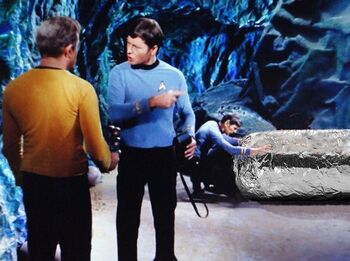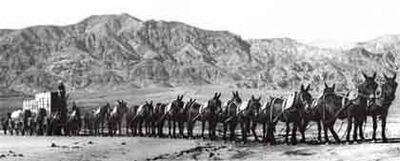Mission burrito
The Mission burrito, scientific name: Burritas humongus, is a species related to the common burrito. It is native to the areas around San Francisco, California (USA) with a range extending across the region. It is named for San Francisco's Mission district where it was first observed in its wild state by naturalist Clounn Alley.
This species is largely found in urban and suburban areas. Therefore, its survival is remarkable as the region has become more heavily populated so that the number of predators has increased. While the common burrito still exists, the Mission species has generally crowded out their smaller relatives in the local ecosphere based on sheer size.[1]
The Mission burrito has now taken over the ecological niche once occupied by the long-extinct Doggie Diner Dog (Canis unwienerschnitzelides) and is threatening to replace the endangered Orange Julius (Arcticus naranjoensis).
Commercial hunting of the Mission type has now replaced hunting by individuals, who now prefer to shoot each other rather than something to eat.[2] Mission burritos are common fare at San Francisco Bay Area taquerias and Mexican restaurants, where they are typically served whole. Their preparation is apparently a closely guarded secret, with the burrito either appearing from behind curtains or swinging doors, or made to "appear" in a cloud of steam. Takeout customers are always asked the mandatory laconic question, "You want chips?".[3]
Commercial breeding has attempted to further increase the size of the Mission burrito. However, the size has been found to be limited by its thin shiny protective skin. Too large a burrito causes a skin failure of epic proportions, usually fatal to the burrito. Attempts at sales by vending machine have failed for similar reasons, though floor collapses caused by fully loaded machines have also been reported.[4]
Identifying characteristics[edit]
The Mission type is immediately distinguished by its much larger size compared to its cousin burrito. Dissection of specimens prove it is an omnivore, with rice, meat and plant matter found as part of its diet.[5] However, some specimens are found with only rice and a variety of plant matter. Backyard avocado trees and tomatoes supplement the burrito’s diet.
The Mission burritos outer skin is thin aluminum.[6] It is secreted by the beast after consumption of aluminum compounds in the soil. The burrito now feeds largely on soda cans and abandoned automobiles for that purpose. The shiny skin is thought to attract mates. That shininess also attracts predators but it is thought that its reflection of the sun can also temporarily blind them. Plus the burrito often hides temporarily in makeshift spots like paper bags. The skin is fragile, as mentioned earlier, therefore its jumping ability is severely limited.
History[edit]
The Mission burrito is said to have been a creation of the 1960s in the then-largely Hispanic Mission district of San Francisco. But with LSD, ganja, the Summer of Love and all that, that story is readily disbelieved. It has been also said that once great herds of Mission burritos darkened the flatlands and hills of the Bay Area. But it has always been an urban and suburban creature. That story has been traced to Mark Twain, himself a mythical creation made up to sell newspapers.
Paleontologists led by Drs. Victoria Stations and Sandy Schrafft have found evidence of pygmy mammoths living in what is now California. As human hunting began to reduce their numbers, they adopted protective camouflage[7] by wrapping themselves in finely crushed plant seeds like maize (corn).
Jean-Baptiste Lamarck (b. 1829, région de la Petite Boulangerie) theorized that the animal by necessity evolved into the burrito form. His proof is that pygmy mammoths no longer exist in California. Trofim Lysenko (b. 1898, Puppentako, Ukraine) continued and expanded Lamarck’s research. He showed how Mission burritos knew to consume aluminum compounds to produce their protective skin. Eminent intelligent design scientists like G. D. Ritzy and Lum Lyon have confirmed this.
In 1845, Mexican dictator Antonio López de Santa Anna, then a fugitive, was captured by Indians in Xico (English: "White Tower"). They threatened to cook and eat him. As Mexican military uniforms of the time were made of pretty rough wool, the idea came up to wrap him in a tortilla first. While some Indians searched for enough maize for the job, others turned him over to the authorities, and the group had to settle for Chinese takeout. Still, the concept of something large and meaty wrapped in a tortilla entered the public consciousness.
When Mission burritos were discovered in Alta California, whole Mexican towns were abandoned in the famed Burrito Rush.[8] Mexico’s population only stabilized when home delivery was promised by its government.
In the 1860s, Remi Nadeau established a freight service crossing the Mojave Desert that carried silver ore from the Howard Johnson and Weenie Beenie mines in the Cerro Gordo area. He purposely chose giant wagons pulled by a team of 18 mules in order to carry Mission burritos back to the mining camps, two per wagon. The burritos were shot by hunters, cooked and rushed to the freight office. Since the burritos were subject to the intense desert heat, they were wetted down with a special solution before shipping. This created the mojado or "wet" style of burrito. Immigrants run down by Nadeau's wagons in the desert were then also called mojados. [9]
Subspecies discovered[edit]
To burritologists' surprise, a slightly smaller variant was found outside the Mission burrito's normal habitat. It was first discovered and identified in 1993 in Colorado by Prof. I. Hopp. He named it Burritas humongus chipotlii, later nicknamed the Chipotle burrito. Thus, the range of the Mission burrito has technically been extended in a huge jump that has puzzled scientists. Researchers Horn and Hardart suspect that the creature was purposely transplanted there. Scientists have yet to pin the blame on one specific ethnic group as many different ones are seen eating these non-native beasts. Burritas humongus chipotlii has further extended its range across the United States, with some even sighted in other countries.
Its ability to survive in colder climates has been questioned.[10] But as breeding self-sustaining colonies of tropical parrots are found in many worldwide urban areas, other invasive species will follow, like Mariachis.[11] The Chipotle burrito has yet to be targeted as an invasive species, despite a number of incidents of its hungry hunters being felled by its sometimes venomous nature.
Rumors of an elusive Himalayan Snow burrito similar to the Mission burrito have been reported but not confirmed. A 1998 Russian science team searching for it disappeared without a trace, with what looked like blood and foil shreds found in their last camp at the 8,000 meter mark on K2.[12]
Footnotes[edit]
- ↑ That saves us from the mini abominations that are just the equivalent of cocktail weenies.
- ↑ A perennial favorite. See also Bang, Bang – Sonny & Cher (1966).
- ↑ This ain't bleeding codfish is it, luv, thanks. But throw in some salsa, if you please.
- ↑ Never eat anything bigger than your head – B. Kliban.
- ↑ Okay, we all know there’s flour in the tortilla. Don’t get huffy.
- ↑ Aluminium to you Brits and Wikipedia.
- ↑ The German band, of course.
- ↑ Actually, nothing to do with Alex Lifeson, Geddy Lee, or Neil Peart, or even the fake deodorizer.
- ↑ All commemorated today by the "piso mojado" signs you see in restaurants today.
- ↑ How are things in guacamole? – Finian’s Rainbow (1947).
- ↑ Like the dreaded giant sombrero, which has no natural enemies outside Mexico.
- ↑ Killer piroshkis, maybe.



